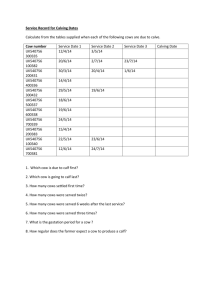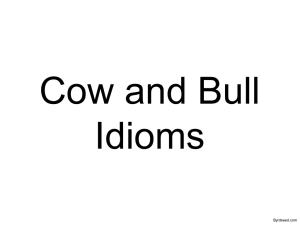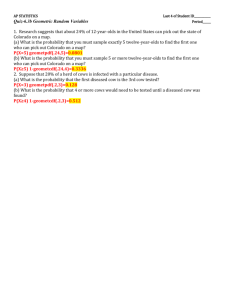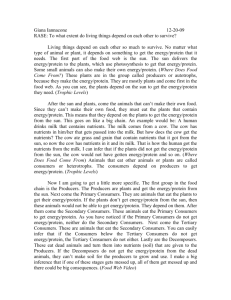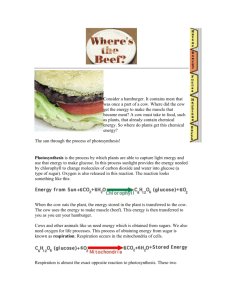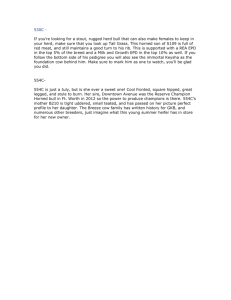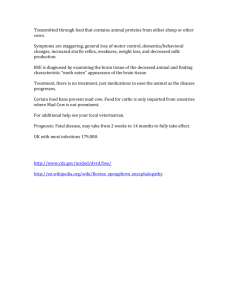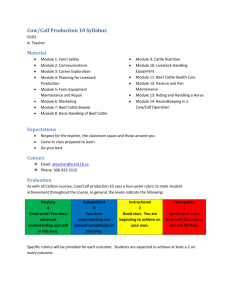Differences Between High, Medium, and Low profit Producers:
advertisement
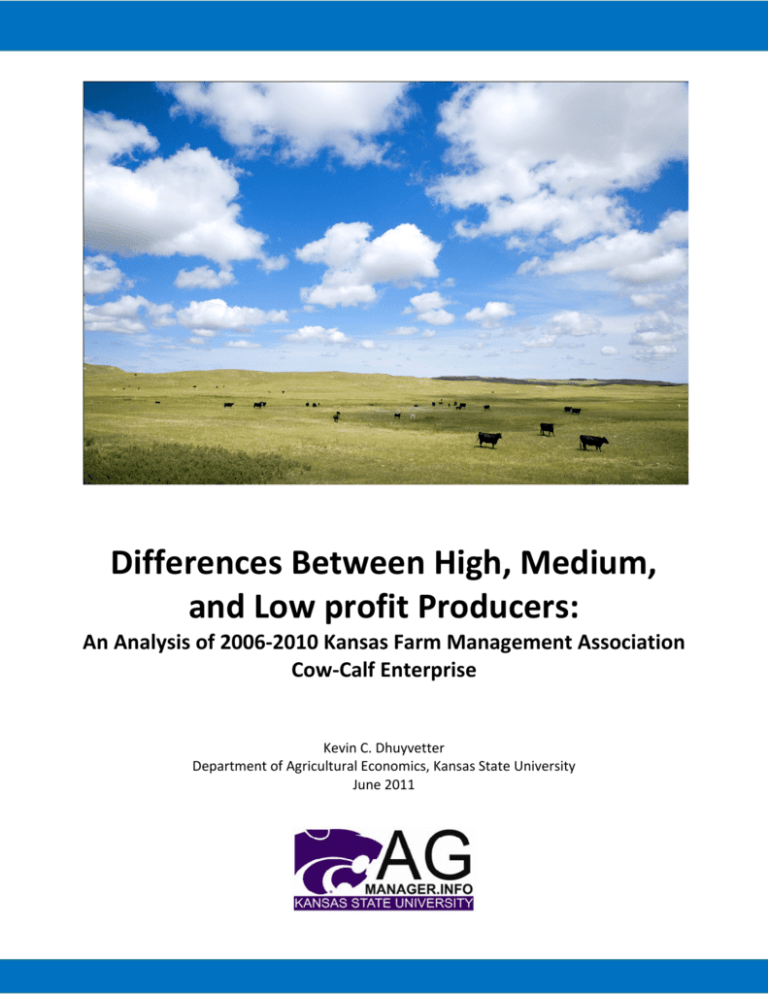
Differences Between High, Medium, and Low profit Producers: An Analysis of 2006‐2010 Kansas Farm Management Association Cow‐Calf Enterprise Kevin C. Dhuyvetter Department of Agricultural Economics, Kansas State University June 2011 Differences Between High, Medium, and Low Profit Cow‐Calf Producers Differences Between High, Medium, and Low Profit Cow-Calf Producers: An Analysis of 2006-2010 Kansas Farm Management Association Cow-Calf Enterprise Kevin C. Dhuyvetter Department of Agricultural Economics, Kansas State University June 2011 Ask any veteran cow-calf prodcer about profitability and they likely will have several “I remember back in…” stories. It is well known that economic returns to cow-calf producers fluctuate considerably over time and year-to-year swings can be extreme. Figure 1 shows returns over variable costs, on a per cow basis, for beef cow-calf producers enrolled in the Kansas Farm Management Association (KFMA) program with cow-calf enterprise records from 1979 to 2010. The number of producers participating in the enterprise analysis averaged 155 per year and ranged from 93 to 258 over the 32-year period. Average annual returns varied from a low of -$76.40 per cow in 2009 to a high of $218.55 in 2004 (a swing of almost $295 in just five years – you don’t have to be much of a veteran to have stories...) and averaged $59.82 per cow over the entire time period. If the 32-year returns in figure 1 are sorted from high (“good years”) to low (“bad years”) and divided into thirds, the average returns for the time periods are $147.40, $61.58, and -$29.53, for the top-, middle-, and bottom-periods, respectively. In other words, there is almost a $177 difference in the average returns per cow in the “good” years compared to the “bad” years, where “good” is defined as the best 1/3 years and “bad” is defined as the worst 1/3 years in nominal terms. Figure 1. Returns over Variable Cost for Cow-calf Enterprise, 1979-2010 250 200 Dollars/cow 150 100 50 0 ‐50 ‐100 79 82 85 88 91 94 97 00 03 06 09 Year 2 Kansas State University Department of Agricultural Economics (Publication: AM‐KCD‐2011.2) www.AgManager.info 2 Differences Between High, Medium, and Low Profit Cow‐Calf Producers This variability of returns over time is due to many factors, but one of the biggest drivers is the cattle cycle. That is, during poor economic times producers tend to reduce the size of their herd which then leads to shorter supplies in the future. These shorter supplies lead to higher prices, which lead to producers expanding their herds creating a larger supply resulting in lower prices (and the process starts over again). Cattle cycles are not perfectly predictable because factors other than price also influence producers’ decisions to expand or contract their herds (forage availability, input costs, etc.). For example, the declining returns in 2007 through 2009 were not the result of herd expansion, but were due more to increasing input costs and weakening beef demand. While some producers try to maintain a “counter cyclical” strategy, it is difficult to avoid the variability in returns depicted in figure 1 because this variability is driven by macro economic factors that impact all producers similarly. Given that factors at the macro level (e.g., interest rates, fuel and feed prices, trade policies, consumer demand) are basically uncontrollable by producers, it stands to reason that variability of returns over time is inherent to the industry. Figure 2 shows similar data as figure 1 only it reflects returns over total costs rather than returns over variable costs. That is, depreciation, real estate taxes, unpaid operator labor and an interest charge on assets have been included in the costs. The average returns over total costs over the 32-year period are -$101.20 per cow ranging from -$286.71 to $68.21 (returns over total costs were only positive 12.5% of the time (4 of 32 years). At first glance one might ask why anybody is in the cow-calf business if returns over total costs are almost always negative. However, it is important to recognize that the value assigned to unpaid labor and assets used in the operation reflect opportunity costs and these can vary significantly between operations. The primary point of figure 2 is that, similar to figure 1, regardless of how we might measure returns (e.g., returns over variable costs, returns over total costs, returns to labor and management), they are highly variable across time. Sorting the 32-year returns over total costs into thirds results in the following averages for the top-, middle-, and bottom-third time periods, respectively: -$6.75, -$94.83, and -$202.03. In other words, there is approximately a $195 difference in the average returns over total costs per cow between the “good” years and the “bad” years. Figures 1 and 2 show the variability in annual average returns across time, where the annual averages are calculated across producers. It was pointed out that this variability across time is due largely to macro economic factors that producers have limited ability to manage. However, an important question for producers to ask is what do the returns for individual producers look like at a point in time? That is, how much variability is there in the returns across individual producers in good or bad years? The answer to this question is important from a management perspective because while producers might not be able to influence overall market conditions, they do have more control of profitability at the farm level relative to other producers. In other words, while numerous factors beyond the producer’s control impact the absolute level of profitability, producers’ management abilities impact their relative profitability. In a competitive industry that is consolidating, such as production agriculture, relative profitability will dictate which producers will remain in business in the long run. Thus, it is important to recognize which characteristics determine relative farm profitability between producers. Specifically, it is important to be able to answer the following questions. Does size of operation impact profitability? Do profitable farms sell heavier calves or receive higher prices? Do they have lower costs? If they have lower costs, in what areas are their costs lower? Answering these questions, and others related to why some producers are more (less) profitable than average provides valuable information for making management decisions. 3 Kansas State University Department of Agricultural Economics (Publication: AM‐KCD‐2011.2) www.AgManager.info 3 Differences Between High, Medium, and Low Profit Cow‐Calf Producers Figure 2. Returns over Total Cost for Cow-calf Enterprise, 1979-2008 100 50 Dollars/cow 0 ‐50 ‐100 ‐150 ‐200 ‐250 ‐300 79 82 85 88 91 94 97 00 03 06 09 Year To consider these questions, cow-calf enterprise costs and returns from the Kansas Farm Management Association (KFMA) Enterprise Analysis for individual producers were divided into three profitability groups, high, middle, and low, based on the per cow return to management.1 A potential problem with analyzing the returns from a group of producers in a given year is that differences could be due more to chance than management. For example, if producers in one part of the state received little or no summer rain, they might have lower weaning weights or higher feed costs (due to supplemental feeding) and hence have below average returns due to weather conditions as opposed to poor management. Similarly, a producer that happens to sell calves in the fall and then the market subsequently rallies might have lower returns than producers that sold their calves 2-3 weeks later, but this difference is likely more due to chance as opposed to management. To reduce the problem of random differences in returns across producers in a given year, a multiyear average is used for each producer. Specifically, the returns for producers that had a minimum of three years of data over the 2006-2010 time period were included in the analysis.2 Operations 1 The words profitability and profit used in this paper refer to the Net Return to Management measure reported in the Kansas Farm Management Association Enterprise PROFITCENTER Summary reports (see Enterprise Reports at www.agmanager.info/kfma/). Net Return to Management is gross income less total costs, which includes unpaid labor, depreciation, and a charge for owned land. 2 Ideally, it would be preferred to have examined the returns for all producers having three or five years of continuous data, however, when that stipulation was used the sample size dropped significantly because not all cow-calf producers conduct an enterprise analysis every year. For example, there were only 12 operations that had data each year from 2006-2010. Likewise, there were only 38 operations that had data each year from 2008-2010. 4 Kansas State University Department of Agricultural Economics (Publication: AM‐KCD‐2011.2) www.AgManager.info 4 Differences Between High, Medium, and Low Profit Cow‐Calf Producers with an average calf selling weight greater than 700 pounds were excluded from the analysis as this likely would represent operations that backgrounded calves and the focus of this analysis is on the cow-calf enterprise. In addition to being excluded from the analysis because of insufficient years of data (i.e., less than three years from 2006-2010), operations also were excluded from the analysis if they had less than 10 cows, if they had not recorded production, if their cattle purchases were greater than 25% of their herd in any one year, or if their net sales (sales less purchases) of breeding stock were greater than 25% in any one year. After these “filters” were applied, there were 88 operations with multi-year average returns to analyze (12 had five years of data, 29 had four years of data, and 47 had three years of data). These multi-year averages of individual producers’ returns should do a better job of characterizing profitability differences that are due to management abilities as opposed to random returns, which might be the case if only a single year were considered. To allow for easier comparisons, a number of the income and expense categories reported in the KFMA cow-calf enterprise report were aggregated. Gross income per cow is the sum of cattle (calves and breeding stock) sales and other miscellaneous income less cattle purchases. Expense categories considered were feed, vet, marketing, labor, depreciation, machinery, interest, and other.3 In addition to the variables from the cow-calf enterprise analysis, a variable representing the amount of labor allocated to livestock was pulled from the KFMA whole-farm database. While this percentage is not reported for beef cows specifically, i.e., it includes all livestock, it should represent a reasonable proxy of total labor on the farm that is allocated to the cow-calf enterprise for this subset of farms. This variable provides an indication as to the relative importance of the cowcalf enterprise to the total farm. A high percentage indicates a farm specializes in beef cow-calf, whereas, a low percentage indicates the operation relies relatively more on crop enterprises. Multi-year averages were calculated for all variables (e.g., returns, herd size, costs) for each of the 88 operations with a minimum of three years of data. The operations were sorted from high to low based on the average return to management (return over total costs) and then classified as high-, mid-, and low-profit farms. Average returns and costs for all 88 operations and for each of the three profit categories are reported in table 1. Also reported are the differences between the high- and low-1/3 groups both in absolute terms and percentages. High profit farms were larger on average and had slightly heavier calves.4 They also had a higher percentage of their farm labor allocated to livestock than other operations (i.e., they were more specialized in livestock). This is not unexpected given that the average herd size for the high 1/3 is considerably larger than for the low 1/3 (187 cows versus 85). The high-profit farms also received slightly higher prices compared to both the mid- and low-profit operations. High-profit operations generated almost $95 (+20%) more revenue per cow than the low-profit operations. Differences in costs between operations were much larger than the revenue differences. High-profit operations had about a $250 per cow advantage over low-profit farms (-28%) and a $119 advantage over the mid-profit farms. Highprofit operations had a cost advantage in every cost category compared to the low-profit operations. 3 Disaggregated income and expense categories in the enterprise reports can be seen in historical reports available at www.agmanager.info/KFMA/. Beginning in 2009 total feed costs were broken down into pasture and other, but prior to 2009 only total feed costs were available and thus no analysis is down here pertaining specifically to pasture costs. 4 While the objective of this analysis is to focus strictly on the cow-calf enterprise by excluding operations with average weights greater than 700 pounds, it is possible that operations with heavier weights fed their calves for a short time perod (i.e., preconditioned their calves). However, given that the weight differences are relatively small, the heavier weights could also be due to better management and better genetics. 5 Kansas State University Department of Agricultural Economics (Publication: AM‐KCD‐2011.2) www.AgManager.info 5 Differences Between High, Medium, and Low Profit Cow‐Calf Producers With the exception of veterinary expenses, this was also true when compared to the mid-profit operations but the differences were considerably less as would be expected. The average year for the high-profit operations was 8.04, where 2006=6, 2007=7, and so on, compared to 8.18 for the mid-profit farms and 7.99 for the low-profit farms. These means were not statistically different from each other at the 10% level, suggesting that profit differences likely were not driven by specific years producers had data for (remember not all farms have data all years). However, looking at figures 1 and 2 it is possible that part of the profitability differences is due to a year effect, but this impact is most likely quite small (this is discussed more in a later section). Combining the gross income and cost advantages for the high-profit farms results in a net return advantage of $344.90 and $154.98 per cow compared to the low-profit and mid-profit farms, respectively. Thus, even though figure 2 suggests that the average cow-calf producer participating in the KFMA enterprise analysis seldom covers their total costs, the information in table 1 indicates that some producers might consistently earn positive returns. That is, even when the macro economic conditions led to an average loss of $241.48 per cow over this time period, the top third of the producers fared much better than the average (average loss of $74.99). Furthermore, 6 of the 88 producers (roughly 7%) realized a positve return over total costs (average of $21.28 per cow) over this time period. In other words, even though returns are highly variable over time due to hard-to-manage macro economic factors, the variability across producers at a point in time is even larger. These larger differences can potentially be managed and therefore represent opportunities. Table 2 shows similar information as reported in table 1 except the analysis only considers variables costs (i.e., data similar to that shown in figure 1). In this case, the difference in returns between the high- and low-1/3 operations is $263.08 per cow (compared to $344.90 with total costs). While high-profit operations are still larger, the difference is less than reported in table 1. This is what would be expected given that fixed costs are excluded from the analysis, i.e., the benefit to spreading fixed costs over more cows is not a factor here. The fact that the operation size for the different groups is different between the two analyses (i.e., tables 1 and 2) implies that the producers in each category are not the same in both tables. In other words, just because a producer receives a high return over variable costs does not guarantee that this same producer will have a high return over total costs. However, there is a strong correlation (0.88) between the relative ranking of producers’ return over total costs and their relative ranking of return over variable costs. This high correlation suggests that producers that fare well with one measure tend to fare well with the other as well.5 While the total difference between the high-1/3 and low-1/3 operations is less when only including variable costs, the conclusion reached earlier still holds. That is, there is more variability between producers at a point in time than there is on average for the industry across time. Given the large differences in returns across producers, a logical question is what are the factors that lead to these differences? Looking at the data in table 1, it is fairly obvious that cost differences represent a much larger portion of net return differences than differences in income. Almost three-fourths (72.4%) of the average difference in net return to management between highand low-profit farms is due to cost differences. The other 27.6% is due to differences in gross income per cow, part of which is a higher price but also high-profit farms had heavier calves. This is not unexpected in a commodity market where producers are basically price takers, i.e., the ability to differentiate oneself financially from the average is typically done through cost management. 5 For example, of the 29 high-profit farms in table 1, 25 were in the high-1/3 category in table 2. Likewise, of the 29 low-profit farms in table 1, 20 were in the low-1/3 category in table 2. 6 Kansas State University Department of Agricultural Economics (Publication: AM‐KCD‐2011.2) www.AgManager.info 6 Differences Between High, Medium, and Low Profit Cow‐Calf Producers Table 1. Beef Cow-calf Enterprise Returns over Total Costs, 2006-2010 (minimum of three years)* Profit Category Number of Farms Labor allocated to livestock, % Difference between All High 1/3 Mid 1/3 Low 1/3 High 1/3 and Low 1/3 Farms Head / $ Head / $ Head / $ Absolute 88 29 30 29 36.9 47.3 32.0 31.5 % Number of Cows in Herd 134 187 131 85 103 121% Number of Calves Sold 122 173 118 77 96 126% Weight of Calves Sold 576 587 570 573 14 3% Calf Sales Price / Cwt $105.99 $107.19 $105.07 $105.73 $1.46 1% Gross Income $517.70 $561.41 $525.20 $466.24 $95.16 Feed $353.91 $306.48 $361.24 $393.76 -$87.28 -22% Interest $123.81 $106.20 $124.66 $140.53 -$34.33 -24% 20% Vet Medicine / Drugs $18.99 $18.25 $17.92 $20.84 -$2.60 -12% Livestock Marketing / Breeding $13.01 $10.86 $13.24 $14.93 -$4.07 -27% Depreciation $34.39 $25.53 $33.96 $43.71 -$18.18 -42% Machinery $71.05 $56.93 $72.72 $83.46 -$26.54 -32% $107.81 $86.28 $91.21 $146.52 -$60.24 -41% Labor Other Total Cost Net Return to Management $36.20 $25.87 $40.22 $42.38 -$16.50 -39% $759.19 $636.40 $755.16 $886.14 -$249.74 -28% -$241.48 -$74.99 -$229.97 -$419.89 $344.90 * Sorted by Net Return to Management (Returns over Total Costs) per Cow Table 2. Beef Cow-calf Enterprise Returns over Variable Costs, 2006-2010 (minimum of three years)* Profit Category Number of Farms Difference between All High 1/3 Mid 1/3 Low 1/3 High 1/3 and Low 1/3 Farms Head / $ Head / $ Head / $ Absolute % 88 29 30 30 36.9 46.2 39.0 25.3 Number of Cows in Herd 134 165 124 114 51 45% Number of Calves Sold 122 153 114 101 51 51% Labor allocated to livestock, % Weight of Calves Sold 576 595 570 565 29 5% Calf Sales Price / Cwt $105.99 $106.24 $106.95 $104.74 $1.51 1% Gross Income $517.70 $567.55 $532.72 $452.31 Feed $353.91 $307.04 $367.32 $386.91 -$79.87 -21% $28.12 $20.39 $27.77 $36.20 -$15.81 -44% Interest $115.24 25% Vet Medicine / Drugs $18.99 $16.93 $18.53 $21.53 -$4.60 -21% Livestock Marketing / Breeding $13.01 $11.18 $11.78 $16.13 -$4.95 -31% $0.00 $0.00 $0.00 $0.00 $0.00 n/a Machinery $71.05 $56.61 $74.54 $81.89 -$25.27 -31% Labor $10.72 $11.73 $5.71 $14.91 -$3.18 -21% Other $36.20 $27.06 $40.19 $41.22 -$14.16 -34% Total Variable Cost $532.02 $450.94 $545.85 $598.78 -$147.85 -25% Return over Variable Costs -$14.31 $116.61 -$13.12 -$146.47 $263.08 Depreciation * Sorted by Net Return to Management (Returns over Variable Costs) per Cow 7 Kansas State University Department of Agricultural Economics (Publication: AM‐KCD‐2011.2) www.AgManager.info 7 Differences Between High, Medium, and Low Profit Cow‐Calf Producers Figures A1-A13 in Appendix A are scatter graphs showing the relationship between different sets of variables for all 88 operations (here the focus is on returns over total costs again, i.e., the data summarized in table 1). The high-, mid-, and low-profit operations are identified with different symbols in all figures (red triangles are bottom 1/3, blue squares are middle 1/3, and green diamonds are top 1/3). The correlation between the variables is reported in the figure title. The correlation is a statistical measure of how well two variables move together and is bounded by -1.0 and 1.0. A value of -1.0 would indicate the two variables move together perfectly, but in opposite directions and a value of 1.0 indicates two variables move up and down together proportionately. Values close to zero indicate the two variables have little relationship to each other. While scatter graphs and correlations can help give a general feel for what might be going on, it is important not to place too much weight on these results as they do not account for other factors that also might be impacting the results. The following is a brief discussion of the different figures. Gross Income Profit and gross income are positively correlated as might be expected (figure A1) indicating that operations generating greater income tend to be more profitable. However, with a correlation of 0.52, clearly having high gross income does not guarantee high profit. This can also be seen where a number of the bottom 1/3 operations had relatively high gross income. Likewise, some of the most profitable operations had moderate gross income levels. Remembering that gross income was a compilation of all income, it still stands to reason that it will be heavily influenced by price and weight. The data for gross income versus price and gross income versus weight are plotted in figures A2 and A3, respectively. While there is a positive relationship between price and gross income it is not very strong. On the other hand, there is a stronger positive relationship between gross income and selling weight of calf. That is, producers that sell more pounds tend to generate more income, but those getting higher prices may or may not actually have higher income. Thus, strictly from a gross income standpoint, this would suggest producers would be better off to focus on production (i.e., pounds sold per cow) than on price. However, it is also important to remember that the relationship between gross income and return over total costs (profit) was not particularly strong and thus there may be even more important variables, such as cost items, to focus management efforts on. Total Costs Figure A4 shows the relationship between total costs and profit. This relationship is negative as expected, i.e., higher costs lead to lower profits, and the relationship is quite strong (correlation of -0.82). This result confirms what was shown in table 1 – the majority of the differences in returns are due to costs and not due to income. Given that cost management is so important, the next question is what drives differences in costs across operations? Figure A5 shows feed costs versus total costs. These costs are positively correlated as would be expected. While feed costs represent almost half of the total costs, it is clear that other costs are important as some of the top 1/3 operations have higher feed costs than some of the bottom 1/3 operations. We typically would expect that operations that market calves at heavier weights would have higher feed costs per cow, however, the relationship between feed costs and calf selling weight, which is positive, is not particularly strong (figure A6). Figure A7 shows the relationship between feed costs and the size of the cow herd. While this relationship is quite weak, the negative relationship indicates that, on average, larger operations have lower feed costs per cow. While the data used in this analysis do not allow us to know exactly what is causing this, it is likely that larger operations rely less on purchased feeds and they receive volume discounts on the feed they do purchase. 8 Kansas State University Department of Agricultural Economics (Publication: AM‐KCD‐2011.2) www.AgManager.info 8 Differences Between High, Medium, and Low Profit Cow‐Calf Producers Higher labor costs per cow and higher depreciation and machinery costs per cow are associated with higher total costs per cow as would be expected (figures A8 and A10). Furthermore, the relationship between depreciation and machinery costs and total costs is quite strong (similar to feed costs). As with feed costs, both labor and depreciation and machinery are negatively related to operation size (figures A9 and A11). That is, operations with larger cow herds tend to have lower costs per cow in both of these categories. The somewhat stronger negative relationship between operation size and depreciation and machinery costs and labor costs is likely due to the “fixed cost” nature of depreciation and machinery and labor. That is, feed costs per cow are generally considered to be variable costs and thus will not vary as much with operation size, on a per cow basis, compared to costs which are more fixed on a whole-farm basis. Figure A12 plots the total costs against the number of cows in the herd. The negative relationship indicates that economies of size exist, i.e., producers with larger operations tend to have lower costs per cow. However, several points should be made. First, there are only a few herds in this analysis with over 300 cows so we cannot say much about the costs for very large operations. That is, while it appears that costs decrease, on average, as herd sizes increase from 50 to 250 cows, we cannot say what they might be for herds with 1,000+ cows. Second, there is a tremendous amount of variability in costs for a given herd size, which suggests that simply being a “large” operation does not guarantee one of having low costs. In other words, while economies of size exist on average, there are smaller operations that compete quite well with larger operations. Figure A13 plots the percentage of labor allocated to livestock (measure of specialization) against total costs. The negative relationship suggests that those producers that specialize in livestock, i.e., have a higher percent of their total farm labor allocated to livestock, tend to have lower costs and hence be more profitable compared to operations who have relatively more of their labor allocated to crops. While this relationship is not particularly strong, it does hint at the advantage to specializing. Characteristics Impacting Profit and Cost Differences Figures A1 through A13 and table 1 provide some indication as to the factors impacting profit and costs, however, correlations only reflect relationships between two variables rather than accounting for multiple factors simultaneously. Additionally, while it is interesting to examine relationships such as feed costs versus total costs, it is more important to think about causal relationships. That is, what are the characteristics of an operation that lead it to being more profitable or having lower costs? Accordingly, the following equation was statistically estimated using multiple regression to identify factors affecting profit differences between operations [1] Profiti = A0 + A1(Cowsi) + A2(Cows2i) + A3(Weighti) + A4(Pricei) + A5(Feed%i) + A6(Labori),6 where Profit is the profit (return over total costs) per cow, Cows is the number of cows in the herd (head), Cows2 is the number of cows squared, Weight is the average selling weight (lbs/cow), Price is the average selling price ($/cwt), Feed% is the percentage of total costs represented as feed (%), Labor is the percentage of total farm labor allocated to livestock (%),i is an index for individual operation, and A0 through A6 are parameters to be estimated. All variables are multi-year averages 6 Variables to account for the years a producer had data in the sample were also included in the model, but they are not reported as this is not a management factor. That is, it was desired to account for any potential year effect, but to focus on those factors that are more controlled by the producer’s management. Variables to account for year were also included in equation [2]. Coefficients on these variables in both models were not statistically significant indicating that profit and cost differences between producers were not due to varying years included in the multi-year averages. 9 Kansas State University Department of Agricultural Economics (Publication: AM‐KCD‐2011.2) www.AgManager.info 9 Differences Between High, Medium, and Low Profit Cow‐Calf Producers based on the number of years of data each operation had over the 2006-2010 time period. It is expected that the coefficient on Feed% (A5) will be positive because operations that have feed costs as a high percent of total are doing a good job of minimizing non-feed costs and thus are expected to have higher profits. Based on data in figure A12, it is expected that the coefficient on Labor will be positive. Similar to equation [1], the following equation was estimated to identify factors leading to cost differences between operations [2] Costi = B0 + B1(Cowsi) + B2(Cows2i) + B3(Weighti) + B4(Feed%i) + B5(Labori), where Cost is the multi-year average total cost per cow, the other variables are as previously defined, and B0 to B6 are parameters to be estimated. Price is not included in equation [2] because there is no reason to expect that price received for cattle would have any impact on costs per cow. Table 3 reports the results of estimating equations [1] and [2]. In the profit model, equation [1], coefficients on all Cows, Feed%, and Labor were statistically significant. The coefficients on Price and Weight were positive as expected, but they were not statistically significant. The coefficients on Cows and Cows2 were positive and negative, respectively, indicating that profit increases at a decreasing rate as herd size increases up to 386 cows at which point profit begins to decrease. That is, there is a benefit for operations to increase, but this advantage diminishes as operations get larger. The coefficient on Feed% is positive and highly significant indicating that producers who have relatively more of their costs as feed (i.e., relatively less in other categories) are more profitable. For every 1% higher this variable is, profit increased $6.41 per cow, all else equal. The average of this variable across all producers was 47% and it ranged from 27% to 65% indicating the ability to manage non-feed costs can have a huge impact on profitability. For example, an operation having feed costs that represent half of their total costs (50%) would be expected to have returns of $61.40 per cow higher than an operation where feed costs represent 40% of their total costs ($61.40 = 6.14 x (50 – 40)). The coefficient on Labor was positive as expected indicating that producers who specialize more on livestock production, relative to crop production, tend to be more profitable. The R-square value for Equation [1] was 0.3569 implying that roughly 36% of the variation in the dependent variable (profit/cow) was explained by variability in the independent variables. Because returns over total costs (i.e., profit) has been shown to be primarily the result of lower costs, as would be expected, regression results for the cost model were generally consistent with the profit model (table 3). The coefficients on Cows and Cows2 were negative and positive, respectively, indicating that cost decreases at a decreasing rate as herd size increases up to 434 cows at which point costs begin to increase (keep in mind that there were only three operations with more than 400 cows and thus it is likely inappropriate to make strong statements about costs increasing for very large herds). The coefficient on Weight was positive suggesting producers selling heavier cattle have higher costs. This is makes sense given that heavier weight calves likely come from larger cows that require more feed per head or the heavier weight was the result of supplemental feed. As with the profit equation, the coefficient on Feed% is significant (negative in this case as expected) indicating that producers who do a good job managing non-feed costs have lower total costs and hence will be more profitable. For every 1% higher this variable is, total costs decreased $4.23 per cow, all else equal. Likewise, the coefficient on Labor was negative indicating that producers who specialize more on livstock production, relative to crop production, tend to have lower costs per cow. The R-square value for Equation [2] was 0.2765 implying that roughly 28% of 10 Kansas State University Department of Agricultural Economics (Publication: AM‐KCD‐2011.2) www.AgManager.info 10 Differences Between High, Medium, and Low Profit Cow‐Calf Producers the variation in the dependent variable (cost/cow) was explained by variability in the independent variables. Table 3. Regression Results for Profit and Cost Models (Equations [1] and [2]) Variable Profit ($/cow) Coefficient p-value* Intercept -4776.64 (0.059) 3441.48 (0.130) 0.97 (0.032) -0.70 (0.084) Cows 2 -0.0013 (0.109) 0.0008 (0.254) Weight 0.29543 (0.272) 0.52326 (0.020) Price 1.6046 (0.454) n/a n/a Feed% 6.1424 (0.008) -4.2328 (0.041) Labor 1.7289 (0.025) -1.1505 (0.094) Cows R-square** 0.3569 Coefficient Cost ($/cow) p-value* 0.2765 * p-values associated with hypothesis test that coefficient is significantly different from zero. A value of 0.05 would imply we are 95% confident that value is significantly different from zero (0.01 implies 99% confidence, and so on). ** R-square represents the proportion of variability in the dependent variable (Profit and Cost ) that is explained by variation in the independent variables. Summary There are some significant conclusions to be drawn from the information discussed above. The economic returns to beef cow-calf producers vary significantly over time due to the cattle cycle and other factors. For example, over the last 32 years there has between $177-$195 difference in returns per cow, depending on how returns are calculated, between the good (top 1/3) and the bad (bottom 1/3) years. This is a significant amount of variability, but unfortunately this risk is difficult to manage because it is due to macro economic factors and conditions that are typically beyond the control of individual producers. However, what is much more important is that the variability across producers at a point in time is much larger than the variability over time. In other words, even in the “good years” some producers are losing money and even in the “bad years” some producers are making money. This is important from a management perspective because that means there are things producers can possibly do to improve their operations. This research suggests that while both production (weight) and price do impact profit, they are much less important in explaining differences between producers than costs. In the data analyzed here, economies of size exist such that larger operations tend to have lower costs and hence are 11 Kansas State University Department of Agricultural Economics (Publication: AM‐KCD‐2011.2) www.AgManager.info 11 Differences Between High, Medium, and Low Profit Cow‐Calf Producers more profitable than smaller operations. However, it is important to point out that being a large operator does not guarantee low costs and high profits as a number of mid-sized to smaller operations were competitive. Operations that specialized more in livestock enterprises, relative to crop enterprises, based on their labor allocation tended to have lower costs and be slightly more profitable. The factor that is extremely important regarding profit and cost differences between producers is how well they manage/control their non-feed costs. Producers that had a high percentage of their total costs as feed (i.e., a low percentage as non-feed) had significantly lower costs and hence significantly higher profits. One of the ways to manage these non-feed costs is operation size as larger operations tended to have lower costs per cow for labor and especially for machinery and depreciation. As the data reported here clearly show, there is tremendous variability across producers, which means there is room for people to improve their relative situations. However, before one can improve their situation they need to know where they stand relative to other producers. Thus, benchmarking and identifying ones strengths and weaknesses is the first step to deciding where to focus management efforts. 12 Kansas State University Department of Agricultural Economics (Publication: AM‐KCD‐2011.2) www.AgManager.info 12 Differences Between High, Medium, and Low Profit Cow‐Calf Producers Appendix A. Scatter Plots of Various Variables for 88 Beef Cow-calf Operations. Figure A1. Profit versus Gross Income (correlation = 0.52) 100 Return over total costs, $/cow 0 -100 -200 -300 -400 -500 Top 1/3 ($-75 / $561) Middle 1/3 ($-230 / $525) -600 Bottom 1/3 ($-420) / $466) -700 200 300 400 500 600 700 Gross income, $/cow Figure A2. Gross Income versus Selling Price (correlation = 0.21) Top 1/3 ($561 / 587) 700 Middle 1/3 ($525 / 570) Bottom 1/3 ($466) / 573) Gross income, $/cow 600 500 400 300 200 85 90 95 100 105 110 115 120 125 130 135 140 Selling price, $/cwt 13 Kansas State University Department of Agricultural Economics (Publication: AM‐KCD‐2011.2) www.AgManager.info 13 Differences Between High, Medium, and Low Profit Cow‐Calf Producers Figure A3. Gross Income versus Calf Selling Weight (correlation = 0.53) Top 1/3 ($565 / 581) 700 Middle 1/3 ($521 / 577) Bottom 1/3 ($467) / 572) Gross income, $/cow 600 500 400 300 200 400 450 500 550 600 650 700 Selling weight, lbs/calf Figure A4. Profit versus Total Cost (correlation = -0. 82) 100 Return over total costs, $/cow 0 -100 -200 -300 -400 Top 1/3 ($-75 / $636) -500 Middle 1/3 ($-230 / $755) -600 Bottom 1/3 ($-420) / $886) -700 450 550 650 750 850 950 1,050 1,150 Total cost, $/cow 14 Kansas State University Department of Agricultural Economics (Publication: AM‐KCD‐2011.2) www.AgManager.info 14 Differences Between High, Medium, and Low Profit Cow‐Calf Producers Figure A5. Total Cost versus Feed Costs (correlation = 0.69) 1,150 1,050 Total costs, $/cow 950 850 750 650 Top 1/3 ($636 / $306) Middle 1/3 ($755 / $361) 550 Bottom 1/3 ($886) / $394) 450 200 250 300 350 400 450 500 550 600 Total feed costs, $/cow Figure A6. Feed Costs versus Calf Selling Weight (correlation = 0.26) 600 Top 1/3 ($306 / 587) Middle 1/3 ($361 / 570) 550 Bottom 1/3 ($394) / 573) Feed costs, $/cow 500 450 400 350 300 250 200 400 450 500 550 600 650 700 Selling weight, lbs/calf 15 Kansas State University Department of Agricultural Economics (Publication: AM‐KCD‐2011.2) www.AgManager.info 15 Differences Between High, Medium, and Low Profit Cow‐Calf Producers Figure A7. Feed Costs versus Size of Cow Herd (correlation = -0.13) 600 Top 1/3 ($306 / 187) 550 Middle 1/3 ($361 / 131) Feed costs, $/cow 500 Bottom 1/3 ($394) / 85) 450 400 350 300 250 200 0 100 200 300 400 500 600 Number of cows in herd Figure A8. Total Cost versus Labor Cost (correlation = 0.57) 1,150 1,050 Total costs, $/cow 950 850 750 Top 1/3 ($636 / $86) 650 Middle 1/3 ($755 / $91) Bottom 1/3 ($886) / $147) 550 450 0 50 100 150 200 250 300 350 Labor costs, $/cow 16 Kansas State University Department of Agricultural Economics (Publication: AM‐KCD‐2011.2) www.AgManager.info 16 Differences Between High, Medium, and Low Profit Cow‐Calf Producers Figure A9. Labor Cost versus Size of Cow Herd (correlation =-0.31) 350 Top 1/3 ($86 / 187) 300 Middle 1/3 ($91 / 131) Bottom 1/3 ($147) / 85) Labor costs, $/cow 250 200 150 100 50 0 0 100 200 300 400 500 600 Number of cows in herd Figure A10. Total Cost versus Depreciation and Machinery Costs (correlation =0.67) 1,150 1,050 Total costs, $/cow 950 850 750 650 Top 1/3 ($636 / $82) Middle 1/3 ($755 / $107) 550 Bottom 1/3 ($886) / $127) 450 0 50 100 150 200 250 300 Depreciation and machinery costs, $/cow 17 Kansas State University Department of Agricultural Economics (Publication: AM‐KCD‐2011.2) www.AgManager.info 17 Differences Between High, Medium, and Low Profit Cow‐Calf Producers Figure A11. Depreciation and Machinery Costs versus Size of Cow Herd (correlation = -0.29) 300 Top 1/3 ($82 / 187) Dep and mach costs, $/cow 250 Middle 1/3 ($107 / 131) Bottom 1/3 ($127) / 85) 200 150 100 50 0 0 100 200 300 400 500 600 Number of cows in herd Figure A12. Total Cost versus Size of Cow Herd (correlation = -0.36) 1,150 Top 1/3 ($636 / 187) 1,050 Middle 1/3 ($755 / 131) Bottom 1/3 ($886) / 85) Total costs, $/cow 950 850 750 650 550 450 0 100 200 300 400 500 600 Number of cows in herd 18 Kansas State University Department of Agricultural Economics (Publication: AM‐KCD‐2011.2) www.AgManager.info 18 Differences Between High, Medium, and Low Profit Cow‐Calf Producers Figure A13. Total Cost versus Labor Allocated to Livestock (correlation = -0.26) 1,150 Top 1/3 ($636 / 47%) Middle 1/3 ($755 / 32%) 1,050 Bottom 1/3 ($886) / 31%) Total costs, $/cow 950 850 750 650 550 450 0 20 40 60 80 100 Percentage of labor allocated to livestock, % 19 Kansas State University Department of Agricultural Economics (Publication: AM‐KCD‐2011.2) www.AgManager.info 19
